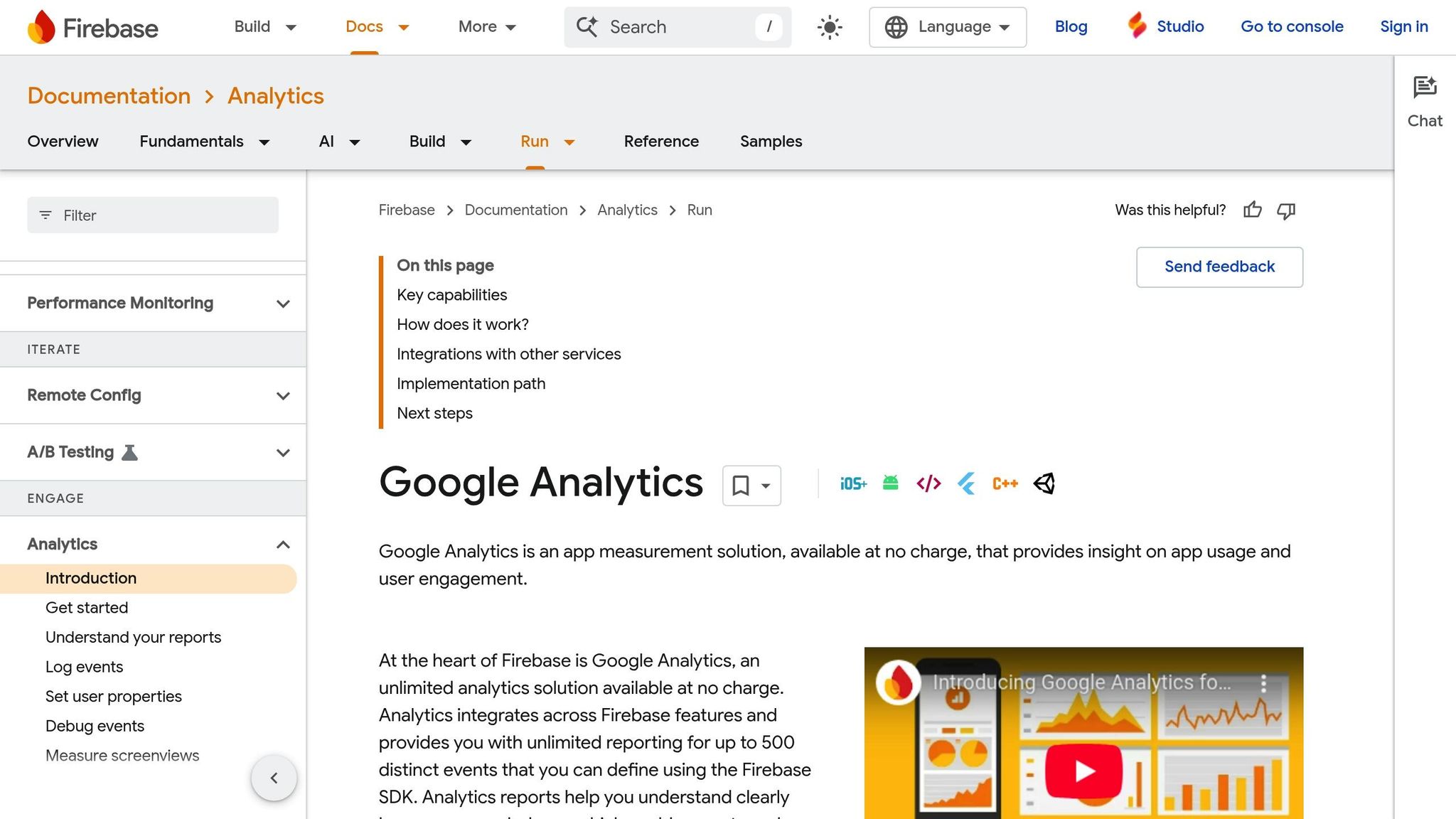Tracking custom events in mobile e-commerce apps lets you focus on user actions that directly impact your business, like adding items to a cart or using discount codes. Unlike standard analytics, custom events provide detailed insights into user behavior, helping you improve your app’s sales funnel, personalize experiences, and optimize marketing efforts. Here’s how to get started:
- Define What to Track: Identify key user actions (e.g., wishlist additions, cart abandonments) tied to your business goals.
- Choose the Right Analytics Tool: Look for features like real-time data, flexible parameters, and easy SDK integration. Popular options include Firebase Analytics, Mixpanel, Amplitude, and Heap.
- Set Up Clear Naming Conventions: Use consistent, descriptive names for events and parameters to keep your data organized.
- Integrate and Test: Add the analytics SDK to your app, validate event tracking, and monitor for issues like missing data.
- Analyze and Act: Use dashboards to identify trends, improve user flows, and target marketing efforts based on real behavior.
Custom event tracking transforms raw data into actionable insights, helping you refine your app and grow your business. Let’s explore the details.
Firebase Analytics Tutorial Part 2: Event Tracking and Implementation with Xcode and SwiftUI

How to Choose the Right Analytics Tool for Custom Event Tracking
Picking the right analytics tool can transform user data into actionable insights, driving revenue and growth. But choosing the wrong one? That can leave you with incomplete data and missed opportunities. With so many platforms available, it’s crucial to focus on the features that match your business needs. Let’s break down the must-have features for any analytics tool.
Key Features to Look for in Analytics Tools
Real-time data processing is non-negotiable. In the fast-paced world of mobile e-commerce, waiting hours for data updates can mean lost sales. Choose tools that process events instantly so you can react to user behavior on the fly. This is especially important during flash sales, product launches, or when troubleshooting checkout problems.
Scalability matters, too. Your analytics platform should grow with your business without compromising performance. Usage-based pricing models, like the one offered by Statsig, make it easy for startups and enterprises alike to adapt as their needs evolve.
Easy SDK integration can save your development team a ton of time. The best tools offer native SDKs for platforms like iOS, Android, React Native, and Flutter. Take Firebase Analytics, for example - it integrates seamlessly with mobile apps, automatically collects key user events, and supports unlimited custom event logging with up to 25 parameters per event. This simplicity reduces engineering overhead.
Flexible event parameters and export options are essential for detailed analysis. Your tool should support multiple parameters per event and allow custom properties while integrating smoothly with your marketing stack, customer support tools, and business intelligence platforms. This ensures you can build comprehensive user profiles and automate responses based on behavior.
Retroactive analysis capabilities can be a game changer. Platforms like Heap automatically capture every user interaction, meaning you can go back and define events or create funnels from historical data. This eliminates the frustration of realizing too late that you should’ve been tracking something all along.
Top Analytics Tools for Mobile E-commerce
Here’s a closer look at some of the best analytics tools for mobile e-commerce:
Google Analytics 4 (GA4) with Firebase is a popular choice for mobile businesses. Firebase Analytics offers free, mobile-optimized analytics, while GA4’s event-driven model is perfect for tracking complex user journeys - from ad clicks to purchases. Plus, seamless integration with Google Ads and other Google tools adds even more value for businesses already in the Google ecosystem.
Mixpanel stands out for its fast event querying and interactive dashboards. It’s a favorite among mobile startups focused on feature adoption and retention. With powerful segmentation and cohort analysis tools, Mixpanel helps you track how different user groups behave over time. Its real-time data processing also lets you monitor engagement and campaign performance as they happen.
Amplitude is tailored for product and growth teams. Its event-based model is ideal for mobile apps, offering deep insights into engagement, retention, and the user lifecycle. Amplitude’s self-serve analytics make it easy for teams to explore user journeys and predict future behavior without needing advanced technical skills.
Heap takes a unique approach with its autocapture technology. This feature automatically tracks every user interaction, removing the need for manual event setup. You can retroactively define events and analyze historical data, saving engineering resources and ensuring you’re never missing key insights.
Countly is perfect for businesses that prioritize data privacy and control. As an open-source platform that supports self-hosting, Countly gives you full control over your data. Its flexible event tracking and privacy-focused approach make it a great option for companies in regulated industries or those with strict data governance requirements.
For a broader comparison, check out the Marketing Analytics Tools Directory (https://topanalyticstools.com). This resource categorizes and compares analytics platforms, helping you find tools tailored to real-time tracking, audience insights, campaign performance, and more.
When choosing a tool, consider starting with a free tier or trial to see how it fits your existing setup. Pay attention to the ease of use, dashboard intuitiveness, and whether the data export options align with your long-term goals. The right analytics tool should blend seamlessly into your operations, enhancing your ability to make data-driven decisions without adding unnecessary complexity.
How to Define and Structure Custom Events
Nailing your custom events from the get-go can save you a ton of trouble down the line. A poorly thought-out structure can lead to messy data and missed opportunities for insights. But when you take a thoughtful approach, you’ll create a system that grows with your business and delivers actionable, reliable data.
How to Identify Events to Track
Start with your business goals - don’t just track everything you can for the sake of it. Every event you set up should tie directly to a key performance indicator (KPI) or a specific business objective.
Focus on interactions that highlight conversion opportunities or potential friction points. For mobile e-commerce, this often includes actions like product searches, adding items to a cart, starting checkout, completing payments, and even post-purchase activities like leaving reviews or making repeat visits. These events are the building blocks for understanding your conversion funnel.
Take a step back and map out your customer journey. Pinpoint the critical moments where decisions are made, and prioritize tracking events that drive immediate actions. For example, abandoned cart notifications or low-stock alerts can trigger automated marketing efforts. Walk through your app as if you were a customer, paying attention to where users might drop off or take meaningful actions. Tracking something like discount code usage can show how promotions impact buying decisions, while monitoring wishlist additions can reveal purchase intent.
Don’t overdo it by trying to track every single interaction. Instead, focus on a manageable set of core events that happen often enough to provide solid insights and are impactful enough to guide decisions. Once you’ve identified these key events, the next step is to define them clearly.
Best Practices for Event Naming and Parameters
After identifying the events that matter, a clear naming and parameter strategy is crucial for keeping your data consistent and easy to use. Stick to a consistent naming structure, such as the [action]_[object] format. For example: click_signup_button, view_product_page, user_signed_up, or checkout_completed.
Keep event names short but descriptive. For instance, product_view is much clearer than something vague like page_load or overly long names like user_navigated_to_product_detail_page_and_viewed_content. The goal is to strike a balance - your data should be easy to interpret in analytics tools without being overly complicated.
Use parameters to add context instead of creating a separate event for every variation. Instead of having unique events for each product category viewed, use a single event like view_product_page and include parameters such as product_id, category, price, and brand. This approach keeps your event list manageable while still providing rich data for segmentation.
Consistency is key when naming parameters. If you use user_id for one event, don’t switch to customer_id or uid elsewhere. Similarly, ensure that parameters like purchase_amount are always formatted consistently (e.g., 29.99 for dollars and cents) and that strings like payment_method use standardized values such as "credit_card" or "paypal." Clear definitions reduce analysis errors and make reporting more accurate.
Document everything. Create a shared guide that includes event names, descriptions, parameters, expected values, and examples of when each event should trigger. This documentation will be a lifesaver for onboarding new team members and troubleshooting any tracking issues.
Think ahead by leaving room in your naming conventions for future growth. For example, starting with purchase_completed makes it easy to add related events like purchase_refunded or purchase_exchanged later without disrupting your current structure.
Lastly, test your naming conventions with your team to ensure clarity. A little feedback early on can save you from headaches later when analyzing your data.
sbb-itb-5174ba0
How to Implement Custom Event Tracking in Mobile Apps
Once you've defined your events and parameters, it's time to bring them to life. This phase is where all your planning turns into action, but it demands careful attention to technical details and thorough testing to ensure everything functions smoothly.
How to Integrate Analytics SDKs
The first step toward implementing custom event tracking is integrating the right analytics SDK into your mobile app. Most popular platforms offer SDKs tailored for both iOS and Android, simplifying the process of collecting and transmitting data.
For iOS, you can add the SDK using CocoaPods, Swift Package Manager, or by manually downloading and importing it into your app delegate. Android apps follow a similar process, relying on Gradle dependencies and initializing the SDK in the main activity or application class.
Firebase Analytics is a popular choice for mobile e-commerce apps due to its simplicity. Once the Firebase SDK is added to your project, you can track custom events with just a few lines of code. For example, in Swift, you might use:
Analytics.logEvent("view_item", parameters: [
"item_id": "12345",
"item_name": "Blue Sneakers",
"category": "Footwear"
])
On Android, the syntax is similar, utilizing the FirebaseAnalytics instance.
Amplitude is another solid option, particularly for behavioral analytics. After initializing the SDK with your API key, you can track events immediately. The SDK also handles batching and sending data efficiently in the background.
Mixpanel focuses on detailed user analytics. After initializing with your project token, you can track events and set user properties. Mixpanel also includes helpful features like A/B testing and push notifications, which can be valuable for e-commerce apps.
To ensure smooth tracking, initialize your chosen SDK as early as possible in your app's lifecycle. For iOS, this typically means using the application:didFinishLaunchingWithOptions: method, while Android apps should initialize in the onCreate() method of the main activity. This ensures events are captured from the moment users open your app.
Most SDKs can queue events offline and send them when connectivity is restored. However, you should still add error handling around your event tracking calls to prevent crashes if something goes wrong.
Privacy considerations are critical during integration. Ensure your analytics platform complies with regulations like GDPR and CCPA. Many SDKs now include built-in consent management tools, allowing you to control data collection based on user preferences. These measures not only keep your tracking compliant but also maintain user trust.
To future-proof your setup, consider building a wrapper layer around your SDK calls. This abstraction allows you to switch analytics providers or send events to multiple platforms without rewriting your entire implementation. An analytics manager class can provide a consistent interface across your app.
Once integration is complete, the next step is rigorous testing and validation.
How to Test and Validate Event Tracking
Testing your event tracking implementation is just as important as the initial setup. Broken or missing events can create significant data gaps, making it hard to understand user behavior or measure marketing performance.
Use tools like Firebase's DebugView or Amplitude's Live View for real-time debugging. Enable verbose logging during development to catch issues with parameters or network requests.
Create a systematic testing checklist to ensure all your custom events are firing correctly. For an e-commerce app, this might include testing the entire purchase funnel: product searches, category browsing, item views, add-to-cart actions, checkout initiation, payment completion, and post-purchase activities.
Don't overlook edge cases. For instance, test scenarios like users quickly adding and removing items from their cart. Does your tracking handle rapid button taps without issues? Simulate poor network conditions to ensure events are queued and sent properly when connectivity improves.
If possible, leverage automated testing tools. Both iOS and Android offer UI testing frameworks that can simulate user interactions and verify event tracking. Though these tests require extra setup, they can help catch issues after updates.
Cross-check your data across different analytics platforms if you're using multiple tools. While minor discrepancies are normal due to processing differences, significant mismatches may indicate tracking problems.
Set up data validation alerts in your analytics dashboard. Many platforms allow you to configure alerts for drops in event volumes or when specific events stop firing. These alerts can help you quickly identify issues after app updates or server changes.
Regularly monitor your data quality metrics. Look for unexpected spikes or drops in event volumes, and check for missing or null values in event parameters, which could indicate implementation errors.
Finally, involve your team in testing. Have colleagues from various departments use test versions of your app and verify that their actions generate the expected events in your analytics dashboard. Fresh perspectives often catch issues developers might miss.
Document any problems you encounter and how you resolved them. This knowledge base will be invaluable for troubleshooting future issues or onboarding new team members who need to understand your analytics setup.
How to Analyze and Use Custom Event Data
Once you've successfully set up event tracking, the next step is turning that raw data into meaningful strategies. With your events firing and data flowing in, it’s time to dive into the numbers and use them to shape decisions that improve user experience and drive results.
How to Interpret Event Data in Analytics Dashboards
Analytics dashboards are your command center for understanding custom event data. These platforms typically provide a summary of metrics like total event counts, unique user interactions, and key parameter details. Start with these high-level metrics to get a quick overview of user activity, then dig deeper into individual event data for more specific insights. For example, if you're tracking "add_to_cart" events, look at the accompanying parameters to identify which product categories are sparking the most interest or leading to purchases.
Pay special attention to conversion funnels. A high number of "add_to_cart" events doesn’t mean much if those actions don’t translate into completed purchases. Pinpoint where users are dropping off in the funnel - these are your opportunities to improve the user journey and remove friction.
Timing is another critical factor. Analyze when events occur to fine-tune the timing of notifications, promotions, or other interactions. Also, keep an eye on events that suggest user struggles, like repeated views of the same item without further action. These moments can reveal bottlenecks in the process that need attention.
By analyzing this data, you’ll uncover actionable insights, which we’ll explore in the next section.
How to Turn Insights into Action
Now that you’ve gathered insights from your custom event data, it’s time to put them to work. Use these findings to optimize user flows and refine your marketing strategies. The goal is to make measurable improvements based on the data.
Start by addressing areas where users drop off. For instance, if many users view a product but don’t proceed to the next step, evaluate elements like the page design, clarity of product information, or placement of call-to-action buttons. Small adjustments here can make a big difference.
Behavioral data is also a goldmine for personalizing experiences. If certain users frequently browse a specific category, consider offering tailored recommendations or exclusive discounts for those items. Similarly, patterns of cart abandonment can inform follow-up strategies, such as sending reminder emails or offering limited-time deals.
Event data can also guide your marketing resource allocation. By linking event metrics to acquisition sources, you can refine your targeting and craft messaging that resonates better with user behavior. When custom events serve as success metrics, A/B testing becomes even more powerful, allowing you to measure subtle changes in engagement or conversion rates.
Operational improvements are another area where event data shines. For example, if users consistently encounter issues at specific stages, you can streamline those processes or provide additional support. Inventory management, customer service, and even product development can benefit from these insights.
Finally, set up automated alerts for significant changes in key metrics. These alerts help you stay ahead of potential issues or capitalize on emerging trends quickly.
For help choosing the right tools, the Marketing Analytics Tools Directory compares platforms designed to turn event data into actionable insights, ensuring you find one that fits your specific needs.
Conclusion: Key Takeaways
This guide has delved into how focused tracking can transform mobile e-commerce insights. By going beyond basic page views and honing in on specific user interactions, businesses can gain the information they need to streamline conversion funnels, deliver tailored experiences, and drive impactful growth. Let’s recap the key principles to make the most of your analytics efforts.
First, having a well-structured event tracking system is non-negotiable. Pair this with analytics tools that offer features like reliable SDK integration, real-time data processing, and customizable event parameters. To avoid confusion, establish clear naming conventions, focus on tracking the most critical user actions, and maintain consistent parameter formats across your team. This type of preparation lays the foundation for actionable insights as your app evolves.
Equally important is testing. Regularly auditing your setup ensures data quality, which is essential for turning raw event data into actionable strategies. Use conversion funnel analysis to pinpoint where users drop off, identify patterns for personalization, and prioritize product development based on real user behavior. Setting up automated alerts for key metric changes can help you respond quickly to challenges or opportunities.
Tracking isn’t a one-and-done effort. As your app grows and user behaviors shift, it’s vital to review and adjust your tracking strategy to keep it aligned with your business goals. Continuous refinement ensures your analytics remain relevant and valuable.
Finally, for those exploring analytics platforms, the Marketing Analytics Tools Directory is a helpful resource. It offers detailed comparisons of tools tailored for mobile e-commerce event tracking, making it easier to find a solution that fits your technical needs and growth plans.
FAQs
What’s the difference between standard analytics and custom event tracking in mobile e-commerce apps?
The key distinction comes down to how much flexibility and detail each option offers. Standard analytics focuses on tracking general, predefined events such as page views, purchases, or session durations. These features are usually baked into most analytics tools, giving you a broad snapshot of overall user activity.
In contrast, custom event tracking lets you zero in on actions that are specific to your app or website. For example, you can track when users add items to a wishlist, use discount codes, or engage with a loyalty program. This more tailored approach helps you gain a clearer understanding of user behavior and refine the customer experience by focusing on the metrics that matter most to your business goals.
How can businesses protect user data and stay compliant when adding analytics tools to their mobile apps?
To safeguard user data and ensure compliance when adding analytics tools to mobile apps, businesses should focus on transparency and security from the start. Begin by setting up clear consent mechanisms that inform users about what data is being collected and how it will be used. This approach aligns with privacy laws like GDPR and CCPA, ensuring users are well-informed. Don’t forget to keep your privacy policy up-to-date and easy for users to understand.
It’s also important to regularly review and audit the analytics SDKs you’re using. This helps you track data flows and confirm everything meets compliance standards. Combine this with secure coding practices and encryption to protect sensitive user information. By staying ahead of privacy regulations, you can build trust with your users while keeping your app compliant.
What are the best practices for naming custom events to ensure clear and consistent data tracking?
To keep things clear and consistent when naming custom events in mobile e-commerce apps, here are some helpful tips:
- Stick to descriptive and uniform naming styles, like snake_case (e.g.,
add_to_cart) or action_object formats (e.g.,purchase_item), so event names are easy to read and interpret. - Match event names to your app's user actions and logic, ensuring they clearly represent the behavior or action being tracked.
- Avoid tracking too much by focusing on core events that deliver actionable insights, cutting out any redundant data.
- Carefully plan event parameters to add meaningful context - this might include details like product IDs, categories, or transaction values.
Using these practices, you can create a clean and efficient event structure that makes data analysis simpler and more accurate.


